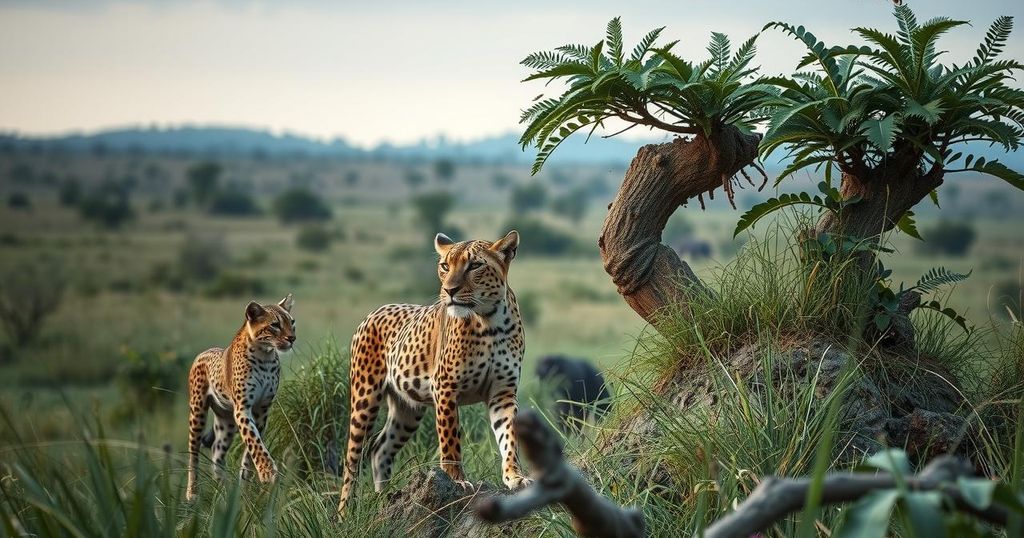The WAP Complex in West Africa is crucial for biodiversity, housing endangered species including small cats such as servals, caracals, and African wildcats, whose status remains poorly documented. The ongoing conflict has made conservation efforts challenging. Despite being categorized as least concern, small cats face threats from wildlife trade, habitat loss, and limited funding for research, underscoring a critical need for investigations into their ecology and conservation status.
The WAP Complex, located across the borders of Benin, Burkina Faso, and Niger, is critical for the conservation of West Africa’s biodiversity and serves as a sanctuary for endangered species. While servals, caracals, and African wildcats inhabit the complex, their population dynamics and ecology remain vastly undocumented. Recent findings have revealed the presence of serval and caracal skins in local medicine markets, yet their origins remain uncertain, raising concerns about the wildlife trade. The ongoing conflict in the region poses significant threats to conservation and research efforts, particularly in the portions of the complex located in Niger and Burkina Faso.
The W-Arly-Pendjari (WAP) Complex is a vast area comprising a mix of ecosystems such as savannas and gallery forests, providing habitat for well-known species like West African lions, savanna elephants, and cheetahs. Despite the status of the small cats as least concern on the IUCN Red List, there is a pervasive lack of fundamental data regarding their populations within the complex and broader West Africa. The persistent insecurity and scarce funding for small cat studies further exacerbate the situation for these species.
Marine Drouilly, a representative from the NGO Panthera, stated, “If I had to summarize in a sentence the situation of small cats in the WAP (and in West Africa in general), I would say that we barely know anything about them and the threats they are facing.” Baseline information on their ecology, distribution, and population dynamics is critically needed. The main protected areas within the WAP Complex include Pendjari National Park in Benin, Arly National Park in Burkina Faso, and the W Regional Park, which spans the borders of Benin, Burkina Faso, and Niger, covering 34,000 square kilometers.
In recent years, escalating violence from jihadist groups in Burkina Faso and Niger has severely hampered conservation efforts, affecting organizations like African Parks, which oversees Pendjari National Park. The majority of the data concerning small cats have emerged from surveys intended for larger species, such as leopards and cheetahs. Small cats, including all three species, have been detected in Pendjari, but comprehensive studies in the other parks have not occurred due to security concerns since surveys from 2016 to 2018.
Drouilly has highlighted the challenges faced by small cats, noting that it is unlikely they are thriving amid ongoing human encroachment and livestock grazing. Despite some improvements in Pendjari National Park under African Parks, human activity is a continuous threat in Arly and W Regional Parks. Consequently, the influence of the current unrest on small cat populations remains largely speculative, although there is a chance that local residents have been displaced by militants, potentially decreasing habitat encroachment.
Furthermore, the wildlife trade continues to threaten servals and caracals with researchers discovering their skins in markets across Benin and Niger. Although a lack of confirmed origins complicates the assessment of these threats, it is evident that servals are sought after for their pelts. Other hazards include the effects of overgrazing and seasonal land burning, which can lead to decreased small mammal populations, adversely impacting the cats’ prey availability. Loss of habitat may bring these felines closer to human settlements, increasing risks of conflict and opportunistic killings.
Despite numerous challenges, acquiring funding for small cat conservation and research remains an ongoing barrier, as funding typically prioritizes species deemed globally threatened. Financial support is essential for assessing the ecological roles of these small cats and their contributions to local ecosystems. Kougbadi from African Parks emphasized that increased research is necessary to understand these felines fully and to develop feasible conservation interventions amidst the complexities of the security climate.
In summary, the plight of small cats within West Africa, particularly in the WAP Complex, necessitates urgent attention. Comprehensive research is vital to shed light on their population statuses, ecological roles, and threats they face. Without further investigation and adequate funding, future conservation undertakings may significantly overlook these lesser-known yet crucial species that inhabit the landscape.
In conclusion, the small feline species within the WAP Complex in West Africa face significant threats amidst ongoing insecurity, lack of research, and wildlife trade. While conservation efforts prioritize iconic larger species, the small cats remain largely underrepresented in studies. It is imperative to enhance understanding of their ecology and address the challenges posed by habitat degradation and conflicts with humans to ensure their survival in this vital ecosystem.
Original Source: news.mongabay.com






